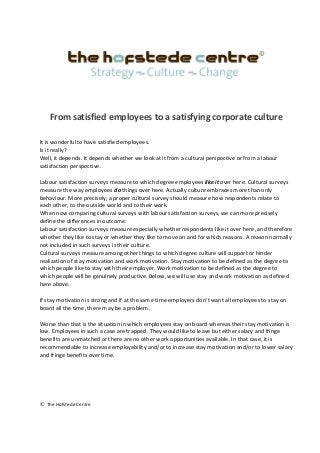6 from satisfied employees to a satisfying culture
- 1. From satisfied employees to a satisfying corporate culture
It is wonderful to have satisfied employees.
Is it really?
Well, it depends. It depends whether we look at it from a cultural perspective or from a labour
satisfaction perspective.
Labour satisfaction surveys measure to which degree employees like it over here. Cultural surveys
measure the way employees do things over here. Actually culture embraces more than only
behaviour. More precisely, a proper cultural survey should measure how respondents relate to
each other, to the outside world and to their work.
When now comparing cultural surveys with labour satisfaction surveys, we can more precisely
define the differences in outcome:
Labour satisfaction surveys measure especially whether respondents like it over here, and therefore
whether they like to stay or whether they like to move on and for which reasons. A reason normally
not included in such surveys is their culture.
Cultural surveys measure among other things to which degree culture will support or hinder
realization of stay motivation and work motivation. Stay motivation to be defined as the degree to
which people like to stay with their employer. Work motivation to be defined as the degree to
which people will be genuinely productive. Below, we will use stay and work motivation as defined
here above.
If stay motivation is strong and if at the same time employers don’t want all employees to stay on
board all the time, there may be a problem.
Worse than that is the situation in which employees stay on board whereas their stay motivation is
low. Employees in such a case are trapped. They would like to leave but either salary and fringe
benefits are unmatched or there are no other work opportunities available. In that case, it is
recommendable to increase employability and/or to increase stay motivation and/or to lower salary
and fringe benefits over time.
© The Hofstede Centre
- 2. Another situation in which you don’t want to find yourself is the following:
Employees’ stay motivation scores high and their work motivation scores low. In other words,
employees love it here, but they are not very much driven to work productively. If you have the
strategic choice between satisfied employees while going bankrupt or employees who are
somewhat less satisfied but who create a success story, the choice will be easily made. Actually,
stay motivation and work motivation don’t necessarily collide. It is possible to create a corporate
culture which enables both strong stay motivation and strong work motivation.
Labour satisfaction surveys measure especially whether your employees are satisfied. If your survey
will tell you that all are satisfied, you will be satisfied as well, as you don’t need to take any action.
What you may not have realized, though, is that by conducting such a survey you have raised
expectations. By abstaining from any follow-up action, rightly so, employees will become less
satisfied, rightly so! This is a catch-22 situation many who are involved in labour satisfaction surveys
may not be aware of.
Surveys scanning the content of your culture will help you to realize your strategic intent as it
covers work reality to a much greater extent than labour satisfaction surveys. Not only that it will
allow you to assess stay and work motivation, but it will also tell you whether your culture will
enable or hinder realization of such issues as: efficiency, ethical and social responsibility, customer
focus, internal cooperation and management support.
Actually it is the challenge to create a culture, called the optimal culture, which will enable the
realization of your strategy, goals and objectives in the best possible way.
The Hofstede model allows you to bring actual culture into focus; taking it from a state of fuzziness
to a state of clarity and preciseness and then comparing it with who you need to be in order to be
most successful.
Bob Waisfisz, founder of The Hofstede Centre
For more information visit geert-hofstede.com or contact info@hofstedecentre.com
© The Hofstede Centre
